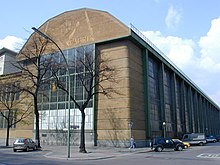This is an old revision of this page, as edited by Викидим (talk | contribs) at 09:27, 26 December 2024 (→top: ce). The present address (URL) is a permanent link to this revision, which may differ significantly from the current revision.
Revision as of 09:27, 26 December 2024 by Викидим (talk | contribs) (→top: ce)(diff) ← Previous revision | Latest revision (diff) | Newer revision → (diff)| This article is actively undergoing a major edit for a little while. To help avoid edit conflicts, please do not edit this page while this message is displayed. This page was last edited at 09:27, 26 December 2024 (UTC) (26 days ago) – this estimate is cached, update. Please remove this template if this page hasn't been edited for a significant time. If you are the editor who added this template, please be sure to remove it or replace it with {{Under construction}} between editing sessions. |

In modern architectural theory, the tectonics is an artistic way to express the corporeality of architectural form and construction through architecture. An example of the use of tectonics and its opposite, atectonics, can be found at the AEG turbine factory: Peter Behrens, the architect, had applied tectonics by exposing the steel frame that supports the roof on the long side of the building, and used atectonics by constructing massive "Egyptian-like" walls in the corners that are not connected to the roof and thus obscure the actual load and support organization of the frontal facade.
This "poetics of construction" has multiple related meanings.
Tectonics is inseparable from the actual buildings and thus counteracts external influences of other visual arts on architecture.
History
The word "tectonic" comes from Ancient Greek: τεκτων, "carpenter, builder" that eventually led to master builder, ἀρχιτέκτων (now architect). First application to modern architecture belongs to Karl Otfried Müller, in Handbuch der Archaologie der Kunst (Handbook of the Archeology of Art, 1830) he defined the art forms that combine art with utility (from utensils to dwellings) as German: tektonische, with the architecture being the peak of this tectonic activities. Karl Botticher in his Die Tektonik der Hellenen (The Tectonic of the Hellenes, 1843-1852) suggested splitting the design into a structural "core-form" (German: Kernform) and decorative "art-form" (German: Kunstform). Art-form was supposed to reflect the functionality of the core-form: for example, rounding and tapering of the column should suggest its load-bearing function. Tectonic system was supposed to bind these multiple facets of a building (Greek temple) into a unified whole (for example, through relief sculptures using structural elements as framing).
Atectonics
Atectonics is an inverse of tectonic, a situation when the artistic appearance of the architectural form is detached from the structure and construction (the structure and construction can also be independent, for example, the forms of the Crystal Palace can be replicated using different materials and techniques). Eduard Sekler introduced the concept of atectonics in 1911 as the arrangement where the interplay between load and support is "visually neglected or obscured". An architect can play tectonics and atectonics simultaneously, see the AEG turbine factory example above.
References
- ^ Yordanova 2019, p. 1056.
- Frampton 2001, p. 21.
- Frampton 2001, pp. 3–4.
- Mallgrave 2009, p. 112.
- Frampton 2001, p. 4.
- Frampton 2001, pp. 20–21.
Sources
- Frampton, Kenneth (2001). Cava, John (ed.). Studies in Tectonic Culture: The Poetics of Construction in Nineteenth and Twentieth Century Architecture. MIT Press. ISBN 978-0-262-56149-5. Retrieved 2024-12-25.
- Mallgrave, H.F. (2009). Modern Architectural Theory: A Historical Survey, 1673–1968. Cambridge University Press. ISBN 978-1-139-44340-1. Retrieved 2024-05-26.
- Yordanova, N.S. (2019). "A new approach to the concept of tectonics". In Cruz, P.J.S. (ed.). Structures and Architecture - Bridging the Gap and Crossing Borders: Proceedings of the Fourth International Conference on Structures and Architecture (ICSA 2019), July 24-26, 2019, Lisbon, Portugal. Structures and Architecture. CRC Press. pp. 1056–1063. ISBN 978-1-351-85815-1. Retrieved 2024-12-25.
This architecture-related article is a stub. You can help Misplaced Pages by expanding it. |